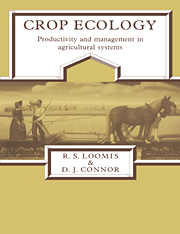Book contents
- Frontmatter
- Contents
- Preface
- Part I Farming systems and their biological components
- 1 Agricultural systems
- 2 Community concepts
- 3 Stability
- 4 Genetic resources
- 5 Development
- Part II Physical and chemical environments
- Part III Production processes
- Part IV Resource management
- References
- Species list
- Conversions and constants useful in crop ecology
- Index
1 - Agricultural systems
from Part I - Farming systems and their biological components
Published online by Cambridge University Press: 05 June 2012
- Frontmatter
- Contents
- Preface
- Part I Farming systems and their biological components
- 1 Agricultural systems
- 2 Community concepts
- 3 Stability
- 4 Genetic resources
- 5 Development
- Part II Physical and chemical environments
- Part III Production processes
- Part IV Resource management
- References
- Species list
- Conversions and constants useful in crop ecology
- Index
Summary
INTRODUCTION
Production of organic materials in farmers' fields depends upon the physiological abilities of plants and on the environment within which they grow. These matters are subject to ecological analyses in terms of biological, chemical, and physical principles. What crops are grown and how they are grown are human decisions, however, depending also upon the usefulness of products, costs of production, and risks involved. Agriculture thus engages technology, economics, and the skills of farmers as well as principles from natural science.
Decisions about cropping practices for individual fields within a farm rest, at one level, on factors such as the field's unique soil characteristics and topography. At the farm level, those considerations must be rationalized with the farm's need for animal feeds, with the availability of labor, and with needs for crop rotation to control disease or erosion. Additional constraints imposed, for example, by market forces and by the availability of capital and technology also influence the strategies and tactics employed by farmers. Through integration into this large scheme of farm management, each field comes to have its own history of use and capability in production.
An understanding of the production ecology of crops and pastures thus extends beyond the boundaries of individual fields to embrace the farming systems of which the fields are a part. This chapter introduces several ideas about farming systems followed by overviews of plant production and the roles played by animals.
- Type
- Chapter
- Information
- Crop EcologyProductivity and Management in Agricultural Systems, pp. 3 - 31Publisher: Cambridge University PressPrint publication year: 1992
- 1
- Cited by



